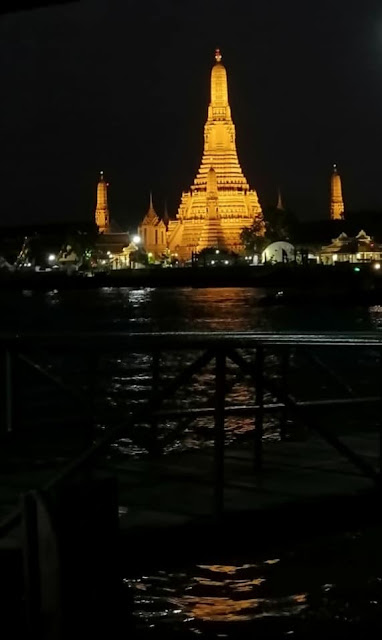Wat Arun Ratchawararam Ratchawaramahawihan (Thai: วัดอรุณราชวราราม ราชวรมหาวิหาร "Temple of Dawn") is a Buddhist temple (wat) in Bangkok Yai district of Bangkok, Thailand, on the Thonburi west bank of the Chao Phraya River. The temple derives its name from the Hindu god Aruna,often personified as the radiations of the rising sun. Wat Arun is among the best known of Thailand's landmarks. The first light of the morning reflects off the surface of the temple with pearly iridescence. Although the temple had existed since at least the seventeenth century, its distinctive prang (spires) were built in the early nineteenth century during the reign of King Rama II.
The temple underwent major restorations during the reign of King Chulalongkorn (Rama V, 1868–1910) and in 1980, prior to the bicentenary celebration of Bangkok's foundation. The most extensive restoration work on the prang was undertaken from 2013 to 2017, during which a substantial number of broken tiles were replaced and lime plaster was used to re-finish many of the surfaces (replacing the cement used during earlier restorations). As the work neared its end in 2017, photographs of the results drew some criticism for the temple's new appearance, which seemed white-washed compared to its previous state. The Fine Arts Department defended the work, stating that it was carefully done to reflect the temple's original appearance.
The main feature of Wat Arun is its central prang (Khmer-style tower) which is encrusted with colourful porcelain. This is interpreted as a stupa-like pagoda encrusted with coloured faience. The height is reported by different sources as between 66.8 m (219 ft) and 86 m (282 ft). The corners are surrounded by four smaller satellite prang. The prang are decorated by seashells and bits of porcelain which had previously been used as ballast by boats coming to Bangkok from China.
The central prang is topped with a seven-pronged trident, referred to by many sources as the "Trident of Shiva". Around the base of the prang are various figures of ancient Chinese soldiers and animals. Over the second terrace are four statues of the Hindu god Indra riding on Erawan.[11] In the Buddhist iconography, the central prang is considered to have three symbolic levels—base for Traiphum indicating all realms of existence, middle for Tavatimsa where all desires are gratified and top denoting Devaphum indicating six heavens within seven realms of happiness. At the riverside are six pavilions (sala) in Chinese style. The pavilions are made of green granite and contain landing bridges.
Front entrance of the "Ordination Hall"
Next to the prang is the Ordination Hall with a Niramitr Buddha image supposedly designed by King Rama II. The front entrance of the Ordination Hall has a roof with a central spire, decorated in coloured ceramic and stuccowork sheathed in coloured china. There are two demons, or temple guardian figures, in front. The murals were created during the reign of Rama V.
The central prang symbolises Mount Meru of the Hindu cosmology. The satellite prang are devoted to the wind god, Phra Phai. The demons (yaksha) at the entranceway to the ubosot are from the Ramakien. The white figure is named Sahassa Deja and the green one is known as Thotsakan, the Demon Rāvana from Ramayana.

วัดอรุณราชวราราม หรือที่นิยมเรียกกันในภาษาพูดว่า วัดแจ้ง หรือที่เรียกสั้น ๆ ว่า วัดอรุณ เป็นวัดโบราณ สร้างในสมัยอยุธยา ที่ชื่อวัดแจ้ง เพราะ พระเจ้าตากฯ ทำศึกเสร็จ แล้วยกทัพกลับมาเป็นเวลาเช้าพอดี ว่ากันว่าเดิมเรียกว่า วัดมะกอก และกลายเป็นวัดมะกอกนอกในเวลาต่อมา เพราะได้มีการสร้างวัดขึ้นอีกวัดหนึ่งในตำบลเดียวกัน แต่อยู่ในคลองบางกอกใหญ่ ชาวบ้านเรียกวัดที่สร้างใหม่ว่า วัดมะกอกใน(วัดนวลนรดิศ)แล้วจึงเรียกวัดมะกอกซึ่งอยู่ปากคลองบางกอกใหญ่ว่า วัดมะกอกนอก ส่วนเหตุที่มีการเปลี่ยนชื่อเป็นวัดแจ้งนั้น เชื่อกันว่า เมื่อสมเด็จพระเจ้าตากสินมหาราชทรงตั้งราชธานีที่กรุงธนบุรีใน พ.ศ. 2310 ได้เสด็จมาถึงหน้าวัดนี้ตอนรุ่งแจ้ง จึงพระราชทานชื่อใหม่ว่าวัดแจ้ง แต่ความเชื่อนี้ไม่ถูกต้อง เพราะเพลงยาวหม่อมภิมเสน วรรณกรรมสมัยอยุธยาที่บรรยายการเดินทางจากอยุธยาไปยังเพชรบุรี ได้ระบุชื่อวัดนี้ไว้ว่าชื่อวัดแจ้งตั้งแต่เวลานั้นแล้ว
เมื่อสมเด็จพระเจ้าตากสินมหาราชโปรดเกล้าฯ ให้สร้างพระราชวังที่ประทับนั้น ทรงเอาป้อมวิชัยประสิทธิ์ข้างฝั่งตะวันตกเป็นที่ตั้งตัวพระราชวัง แล้วขยายเขตพระราชฐานจนวัดแจ้งเป็นวัดภายในพระราชวัง เช่นเดียวกับวัดพระศรีสรรเพชญ์สมัยอยุธยา และเป็นที่ประดิษฐานพระพุทธมหามณีรัตนปฏิมากรที่อัญเชิญมาจากเวียงจันทน์ใน พ.ศ. 2322 ก่อนที่จะย้ายมาประดิษฐานที่วัดพระศรีรัตนศาสดารามในปี พ.ศ. 2327
ในสมัยรัตนโกสินทร์ รัชสมัยพระบาทสมเด็จพระพุทธยอดฟ้าจุฬาโลกมหาราช สมเด็จพระเจ้าลูกยาเธอ เจ้าฟ้ากรมหลวงอิศรสุนทร ได้เสด็จมาประทับที่พระราชวังเดิม และได้ทรงปฏิสังขรณ์วัดแจ้งใหม่ทั้งวัด แต่ยังไม่ทันสำเร็จก็สิ้นรัชกาลที่ 1 สมเด็จฯ เจ้าฟ้ากรมหลวงอิศรสุนทรได้เสด็จขึ้นครองราชสมบัติเป็นพระบาทสมเด็จพระพุทธเลิศหล้านภาลัย พระองค์ได้ทรงบูรณปฏิสังขรณ์วัดแจ้งต่อมา และพระราชทานนามใหม่ว่า “วัดอรุณราชธาราม” ต่อมามีพระราชดำริที่จะเสริมสร้างพระปรางค์หน้าวัดให้สูงขึ้น แต่สิ้นรัชกาลเสียก่อน จนถึงรัชสมัยพระบาทสมเด็จพระนั่งเกล้าเจ้าอยู่หัว โปรดเกล้าฯ ให้เสริมพระปรางค์ขึ้นและให้ยืมมงกุฎที่หล่อสำหรับพระพุทธรูปทรงเครื่องที่จะเป็นพระประธานวัดนางนองมาติดต่อบนยอดนภศูล ในรัชสมัยพระบาทสมเด็จพระจอมเกล้าเจ้าอยู่หัวโปรดเกล้าฯ ให้บูรณปฏิสังขรณ์วัดอรุณราชธารามหลายรายการ และให้อัญเชิญพระบรมอัฐิของพระบาทสมเด็จพระพุทธเลิศหล้านภาลัยมาบรรจุไว้ที่พระพุทธอาสน์ของพระประธานในพระอุโบสถด้วย เมื่อการปฏิสังขรณ์เสร็จสิ้นลง พระราชทานนามวัดใหม่ว่า “วัดอรุณราชวราราม”
#หลวงพ่อแจ้ง หรือ #พระอรุณ พระพุทธรูปปางมารวิชัย ณ วัดอรุณราชวรารามราชวรมหาวิหาร เป็นพระพุทธรูปศิลปะล้านช้างที่มีพุทธลักษณะที่งดงามยิ่ง พระพักตร์อิ่มเอิบ หน้าตักขนาดกว้างเพียง ๕๐ ซม.และหลายท่านมักมองข้าม "หลวงพ่อแจ้ง"
ประดิษฐานอยู่หน้าพระพุทธชัมภูนุทมหาบุรุษลักขณาอสีตยานุบพิตร ซึ่งเป็นพระประธานในวิหาร
เดิมทีหลวงพ่อแจ้งประดิษฐานอยู่ในพระบรมมหาราชวังมาตั้งแต่ปีพุทธศักราช ๒๔๐๑
ต่อมาพระบาทสมเด็จพระจอมเกล้าเจ้าอยู่หัว ร.๔ ทรงโปรดเกล้าฯให้อัญเชิญมาประดิษฐานที่วัดอรุณราชวรารามแทน ด้วยชื่อหลวงพ่อและวัดนั้นสอดคล้องกัน
และทุกวันสงกรานต์ของทุกปี ทางวัดจะมีการอัญเชิญหลวงพ่อแจ้งองค์จำลองแห่วนตั้งแต่ถนนอรุณอัมรินทร์ตลอดเส้นทางไปยังถนนอิสรภาพเพื่อให้ชาวฝั่งธนบุรีได้รดน้ำ เป็นประเพณีที่งดงามที่ชาวฝั่งธนบุรียังคงสืบสานมาถึงปัจจุบัน
Cr.Jaroensook Limbanchongkit Pone
Thank you for great pictures from Noi Art













































































